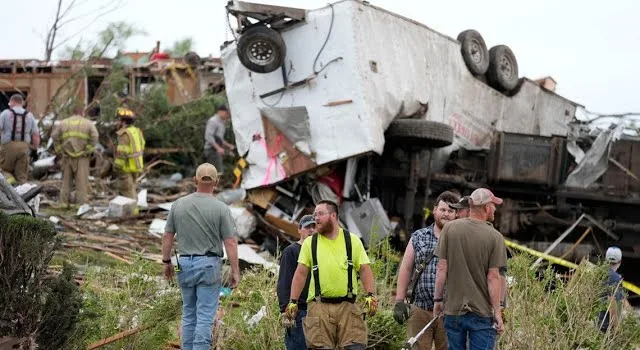Tornadoes cause destruction in Greenfield, Iowa, while severe storms impact Nebraska, Illinois, and other midwest states
At least five people died, and dozens more were injured as powerful tornadoes ripped through Iowa, with one carving a path of destruction through the small city of Greenfield. The tornadoes destroyed homes and businesses, shredded trees, and smashed cars, just weeks after similar storms devastated other parts of the state. Additionally, Nebraska experienced torrential rain, high winds, and large hail.
The Iowa Department of Public Safety confirmed four deaths and at least 35 injuries from the Greenfield tornado in Adair County. Fourteen people were transported to medical facilities outside the county. The number of injured is likely higher as some received treatment at designated alternate care sites. In Adams County, a female driver died when her vehicle was blown off the road by a tornado.
Iowa Governor Kim Reynolds issued a disaster proclamation for 15 counties and visited Greenfield to assess the damage. She described the situation as “tragic” and “gut-wrenching,” noting that a significant portion of the town had been flattened. Many homes, buildings, and the local hospital suffered extensive damage or were destroyed. State Representative Ray Sorensen recounted pulling a man from the rubble and taking him to a makeshift hospital set up in a nearby lumber yard.
Search and rescue missions continued in Greenfield to account for all residents. Iowa State Patrol spokesman Sgt. Alex Dinkla emphasized the importance of ensuring that every person is accounted for, given the extensive destruction of homes. The aftermath left Greenfield devastated, with debris littering the area and damaged houses and cars scattered throughout.
The Adair County Health System hospital in Greenfield sustained damage, and Mercy One officials were assessing the situation. A wind farm near Greenfield suffered a direct hit, crumpling five power-producing towers and causing one to burst into flames. MidAmerican Energy Company reported wind speeds of over 100 mph before the turbines were destroyed.
Powerful storms continued to impact the region. By Wednesday evening, about 3,500 homes and businesses in Iowa remained without power, down from more than 32,000 the previous night. In Nebraska, severe weather caused widespread power outages and flooding, particularly in Omaha. Torrential rain, high winds, and large hail affected the area, with more than 10,000 customers losing power.
In Omaha, weather sirens blared as heavy rain flooded basements and submerged cars. A deluge of over 8 inches of rain led to significant flooding, and firefighters rescued people trapped in vehicles overtaken by water. While tornadoes were not confirmed in Omaha, hurricane-force winds were reported.
Chris Bruin, a meteorologist for The Weather Channel, warned that the storms would likely intensify, producing more destructive tornadoes. Tornado watches extended south to Missouri and Arkansas, with Iowa expected to face the worst conditions. Severe weather also threatened parts of Illinois and Minnesota, with Chicago potentially seeing wind gusts up to 75 mph and possible tornadoes.
The Midwest’s extreme weather followed days of severe storms that impacted Oklahoma, Kansas, Colorado, and Nebraska. Large hail, strong winds, and tornadoes caused significant damage, with some areas experiencing knee-deep hail. In Yuma, Colorado, hail the size of baseballs and golf balls turned streets into rivers of water and ice, causing extensive damage to vehicles and buildings.
Last week, deadly storms in Texas killed at least seven and left hundreds of thousands without power. Hurricane-force winds caused widespread destruction, leaving many without air conditioning during hot and humid weather.
Analysis:
The recent tornadoes and severe storms in the Midwest highlight the increasing frequency and intensity of extreme weather events. The destruction in Greenfield, Iowa, underscores the vulnerability of small towns to natural disasters. Governor Kim Reynolds’ disaster proclamation for 15 counties reflects the widespread impact of these storms. The tornadoes not only caused immediate loss of life and injuries but also long-term disruptions to the community’s infrastructure and economy.
Politically, the response to such disasters often becomes a focal point for evaluating leadership and emergency preparedness. Governor Reynolds’ swift action in issuing a disaster proclamation and visiting the affected areas demonstrates the state’s commitment to addressing the crisis. However, the effectiveness of recovery efforts and support for affected residents will be closely scrutinized.
Sociologically, the tornadoes have disrupted the social fabric of Greenfield. The destruction of homes and community buildings, including the local hospital, challenges the town’s ability to provide essential services and maintain social cohesion. Community resilience will be tested as residents work together to rebuild and support one another.
Economically, the impact of the tornadoes extends beyond immediate damage. The destruction of homes, businesses, and infrastructure results in significant financial losses. Recovery and rebuilding efforts will require substantial investment and the economic burden will be felt by individuals, businesses, and the state. The damage to the wind farm near Greenfield also highlights the vulnerability of renewable energy infrastructure to extreme weather events.
Locally, the response of residents and local officials plays a crucial role in the immediate aftermath of such disasters. The establishment of makeshift hospitals and the involvement of local leaders in rescue efforts reflect the community’s resilience and resourcefulness. However, the long-term recovery will depend on external support and resources.
From a gender perspective, natural disasters often disproportionately affect women, who may face increased caregiving responsibilities and economic challenges. Ensuring that recovery efforts address the specific needs of women and other vulnerable groups is essential for equitable rebuilding.
In terms of race and minority considerations, marginalized communities often experience greater vulnerability to natural disasters due to pre-existing social and economic disparities. Ensuring that recovery efforts are inclusive and address the needs of these communities is crucial for promoting equity and resilience.
Overall, the recent tornadoes in Iowa and severe weather across the Midwest highlight the need for comprehensive disaster preparedness and response strategies. Addressing the immediate and long-term impacts of such events requires coordinated efforts from the government, community organizations, and residents. As climate change continues to influence weather patterns, building resilient communities becomes increasingly important.
